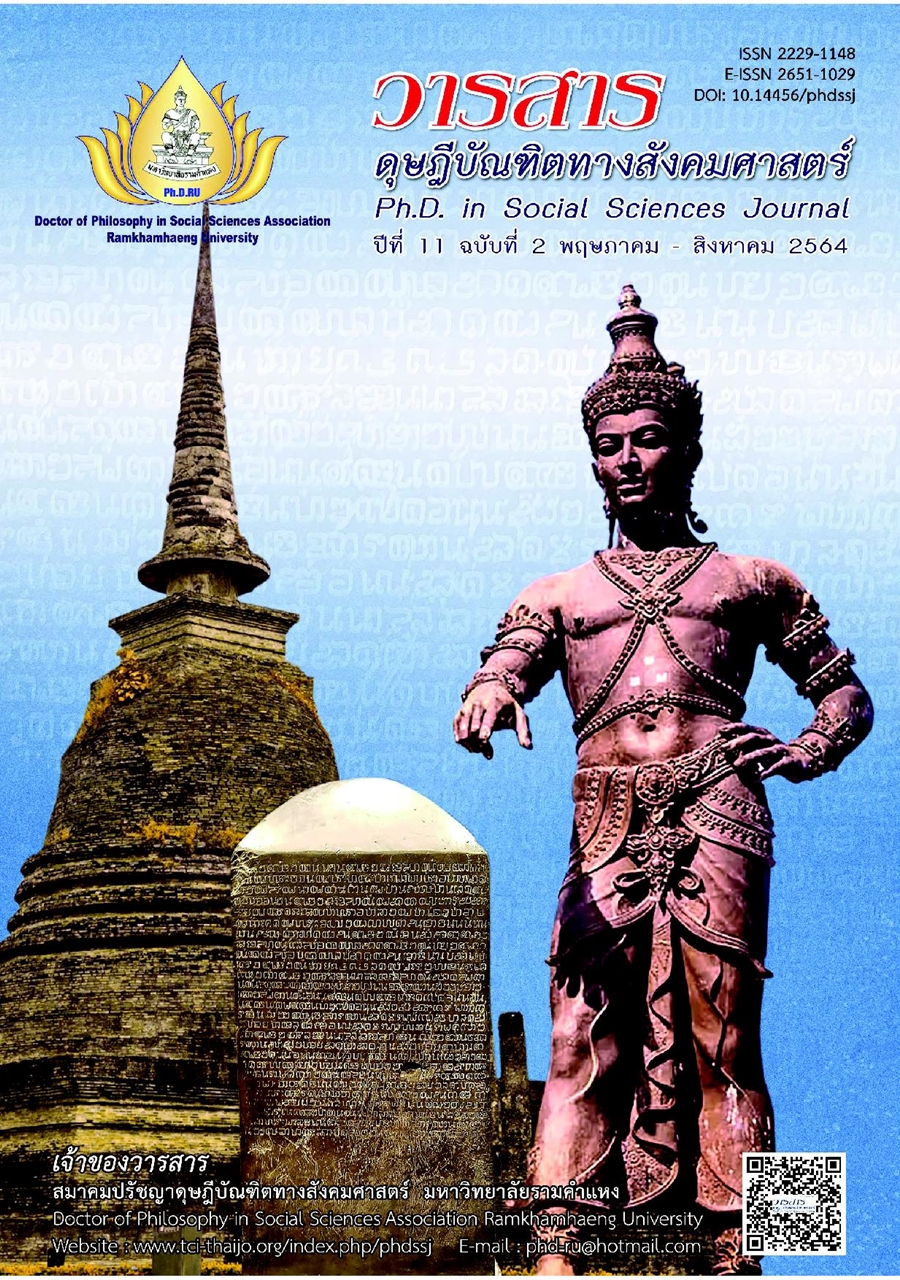อิทธิพลของปัจจัยเชิงสาเหตุที่มีต่อความได้เปรียบทางการแข่งขันของผู้ผลิตสินค้าหนึ่งตำบลหนึ่งผลิตภัณฑ์ (โอทอป) ในประเทศไทย
Main Article Content
บทคัดย่อ
บทความวิจัยนี้ มีวัตถุประสงค์เพื่อ (1) เพื่อตรวจสอบความสอดคล้องของตัวแบบกับข้อมูลเชิงประจักษ์ และ (2) เพื่อศึกษาอิทธิพลของปัจจัยที่มีต่อความได้เปรียบทางการแข่งขันของผู้ผลิตสินค้าหนึ่งตำบลหนึ่งผลิตภัณฑ์ (โอทอป) ในประเทศไทย โดยเก็บข้อมูลจากผู้ประกอบการธุรกิจผลิตภัณฑ์สินค้าหนึ่งตำบลหนึ่งผลิตภัณฑ์ (OTOP) ในประเทศไทย จำนวน 846ราย โดยเก็บรวบรวมข้อมูลโดยใช้แบบสอบถามที่มีค่าความเชื่อมั่นเท่ากับ 0.816 วิเคราะห์ข้อมูลด้วยโปรแกรมสำเร็จรูป Amos โดยใช้เทคนิคการวิเคราะห์แบบจำลองสมการโครงสร้าง และทำการวิเคราะห์ข้อมูลด้วยโมเดลสมการโครงสร้าง (Structure Equation Model--SEM)
ผลการวิจัย พบว่า (1) ดัชนีทุกตัวผ่านเกณฑ์มาตรฐาน ประกอบด้วย ดัชนี p- value = 0.295, CFI = 0.995, GFI = 0.976, AGFI = 0.958, RMSEA = 0.019, RMR = 0.022 ดังนั้น จึงสามารถสรุปได้ว่าผลการวิเคราะห์ที่ได้ครั้งนี้สอดคล้องกับข้อมูลเชิงประประจักษ์ และ (2) จากผลการวิเคราะห์เส้นทางพบว่า ปัจจัยที่มีอิทธิพลต่อความได้เปรียบทางการแข่งขันของผู้ผลิตสินค้าหนึ่งตำบลหนึ่งผลิตภัณฑ์ (โอทอป) ในประเทศไทย ประกอบด้วย ปัจจัยบทบาทของภาครัฐเป็นปัจจัยที่อิทธิพลทางตรงต่อความได้เปรียบทางการแข่งขันมากที่สุด รองลงมา คือ ปัจจัยการเป็นผู้ประกอบการขององค์การ และปัจจัยการจัดการการเปลี่ยนแปลงโดยมีขนาดอิทธิพลรวม 0.526, 0.418 และ 0.265 ตามลำดับ อย่างมีระดับนัยสำคัญทางสถิติที่ 0.01
Article Details
บทความวิชาการ บทความวิจัย และบทวิจารณ์หนังสือในวารสารดุษฎีบัณฑิตทางสังคมศาสตร์ เป็นความคิดเห็นของผู้เขียน มิใช่ของคณะผู้จัดทำ และมิใช่ความรับผิดชอบของสมาคมปรัชญาดุษฎีบัณฑิตทางสังคมศาสตร์ มหาวิทยาลัยรามคำแหง (กรณีการทำวิจัยในมนุษย์ ผู้วิจัยต้องผ่านการอบรมจริยธรรมการวิจัยในมนุษย์ และนำหลักฐานมาแสดง)
เอกสารอ้างอิง
Acquaah, M. (2011). Business strategy and competitive advantage in family businesses in Ghana: The role of social networking relationships. Journal of Developmental Entrepreneurship, 16(1), 103-126.
Ahmad, S. Z. (2014). Small and medium enterprises internationalisation and business strategy: Some evidence from firms located in an emerging market. Journal of Asia Business Studies, 8(2), 168-186.
Angsuchoti, S., Wichitwanna, S., & Phinyopanuwat. (2014). Statistical analysis for research in social science and behavior science: Techniques for using LISREL programs (4th ed.). Charoen Di Mankhong Kanphim. [In Thai]
Awang, A., Asghar, A. R. S., & Subari, K. A. (2010). Study of distinctive capabilities and entrepreneurial orientation on return on sales among Small and Medium Agro-Based Enterprises (SMAEs) in Malaysia. International Business Research, 3(2), 34-48.
Bakar, M. S., & Mahmood, R. (2014). Linking transformational leadership and corporate entrepreneurship to performance in the Public Higher Education Institutions in Malaysia. Advances in Management and Applied Economics, 4(3), 1-8.
Balkyte, A., & Tvaronaviciene, M. (2010). Perception of competitiveness in the context of sustainable development: Facets of sustainable competitiveness. Journal of Business Economics and Management, 11(2), 341-365.
Brockman, B. K., & Morgan, R. M. (2003). The role of existing knowledge in new product innovativeness and performance. Decision Sciences, 34(2), 385-419.
Bustinza, O. F., Bigdeli, A. Z., Baines, T., & Elliot, C. (2015). Servitization and competitive advantage: The importance of organizational structure and value chain position. Research-Technology Management, 58(5), 53-60.
Chen, Y., Tang, G., Jin, J., Xie, Q., & Li, J. (2014). CEOs’ transformational leadership and product innovation performance: The roles of corporate entrepreneurship and technology orientation. Journal of Product Innovation Management, 31(1), 2-17.
Covin, J. G., & Slevin, D. P. (2012). The measurement of entrepreneurial orientation. Entrepreneurship Theory and Practice, 36(4), 677-702.
Davidson, A. (2013). Business model for an era of innovation glut. Ivey Business Journal, 77(4), 1-4.
Department of Community Development. (2018). OTOP operator, 2018. Retrieved from http://www.thaitambon.com/shop/SMEs [In Thai]
Field, A. (2005). Reliability analysis. In A. Field (Ed.), Discovering statistics using SPSS (2nd ed.). Sage.
Ferreira, J. M., & Azevedo, S. (2007). Entrepreneurial orientation as a main resource and capability on small firm’s growth. Retrieved from https://mpra.ub.uni-muenchen.de/5682/1/MPRA_paper_5682.pdf
Hair, J. F., Black, B., Babin, B.J., & Anderson, R. E. (2010). Multivariate data analysis: A global perspective (7th ed). Pearson Education.
Harms, R. (2009). A multivariate analysis of the characteristics of rapid growth firms, their leaders, and their market. Journal of Small Business and Entrepreneurship, 22(4), 429-454.
Kenney, M., & Mujtaba, B. (2007). Understanding corporate entrepreneurship and development: A practitioner view of organizational intrapreneurship. Journal of Applied Management and Entrepreneurship, 12(3), 73-88.
Kerdpitak, C., Tienthai, J., Budsaba, K., & Laptaned, U. (2012). Management model for logistics operations of Thailand’s Palm Oil Industry. University of the Thai Chamber of Commerce. [In Thai]
Kianto, A., Andreeva, T., & Pavlov, Y. (2013). The impact of intellectual capital management on company competitiveness and financial performance. Knowledge Management Research and Practice, 11(2), 112-122.
Liu, W., Zhu, R., & Yang, Y. (2010). I warn you because I like you: Voice behavior, employee identifications, and transformational leadership. The Leadership Quarterly, 21(1), 189-202.
Mason, C., & Brown, R. (2013). Creating good public policy to support high-growth firms. Small Business Economics, 40(2), 211-225.
Miller, D. (1988). Relating Porter’s business strategies to environment and structure: Analysis and performance implications. Academy of Management Journal, 31(2), 280-308.
Ortega, M. J. R. (2010). Competitive strategies and firm performance: Technological capabilities’ moderating roles. Journal of Business Research, 63(12), 1273-1281.
Pongprasertchai, M. (2007). A resource-based view of the competitiveness of Thai Small and Medium-Sized enterprises: A case studies of the food processing export industry. Doctoral Dissertation of Business Administration, Ramkhamhaeng University. [In Thai]
Porter, M. E. (2011). The role of business in society: Creating shared value. Retrieved from https://www.hbs.edu/faculty/Publication%20Files/20111113%20-%20Babson%20CSV%20Presentation%20-%20FINAL%20FINAL_6e5ad9ea-3900-4a91-9534-eb721d30ac9b.pdf
Rauch, A., Wiklund, J., Lumpkin, G. T., & Frese, M. (2009). Entrepreneurial orientation and business performance: An assessment of past research and suggestions for the future. Entrepreneurship Theory and Practice, 33(3), 761-787.
Sturgeon, J. C. (2010). Governing minorities and development in Xishuangbanna, China: Akha and Dai rubber farmers as entrepreneurs. Geoforum, 41(2), 318-328.
The future of the Thai economy and government role. (2015). Retrieved from http://www.bangkokbiznews.com/blog/detail/628666 [In Thai]
Yaghoubipoor, A., Ong, T., & Ahmed, E. (2013). Impact of the relationship between transformational and traditional leadership styles on Iran’s automobile industry job satisfaction. World Review of Entrepreneurship Management and Sustainable Development, 9(1),14-24.
Yitshaki, R. (2012). How do entrepreneurs’ emotional intelligence and transformational leadership orientation impact new ventures’ growth?. Journal of Small Business and Entrepreneurship, 25(3), 357-374.
Zelbst, P. J., Green, K. W., Sower, V. E., & Reyes, P. M. (2012). Impact of RFID on manufacturing effectiveness and efficiency. International Journal of Operations & Production Management, 32(3), 329-350.


